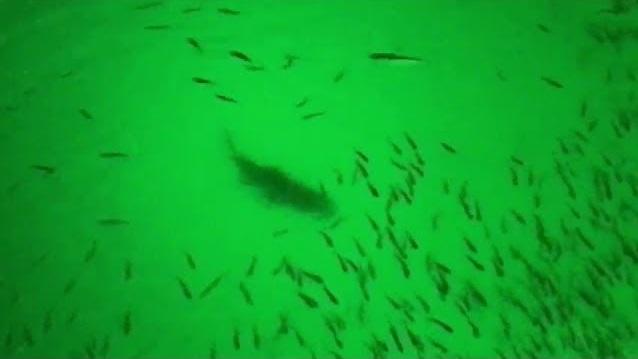
For centuries, mankind has been dealing with barnacles and their effect on fishermen. This continues into the 21st century with anglers such as yourself who use underwater lights. While removing these aquatic creatures from boats has been covered extensively all over the internet, few have addressed our main concern today: how to remove barnacles from underwater lights?
Can you even do that? What is the best way to remove barnacles from underwater lights? Can it be done without damaging the light?
Rest assured, yes, you can remove barnacles from underwater lights and there are several easy things you can do to detach them. Let’s spend a few moments first learning about barnacles before tackling this question.
What is a barnacle?
Before we dive into how to remove barnacles from underwater lights, we thought it would be a good idea to unpack what a barnacle is and why they are a problem. First, barnacles are saltwater arthropods. If it’s been a while since you’ve heard that science term, arthropods are invertebrates: instead of an inside-the-body skeleton like us, they have an exoskeleton.
Humans can eat arthropods. If we didn’t, the seafood chain Red Lobster would need another name! Besides lobster, famous seafood dishes such as shrimp and crabs are also arthropods. In fact, in other countries insects and scorpions are as common as steak and potatoes are in the United States.
So since so many different kinds of arthropods are edible, does this mean barnacles are too? As it turns out, in Japan, Spain, and Chile there are several species of barnacles that the locals enjoy.
However, beyond a food source barnacles are actually a nuisance for humans as they often attach themselves to the hulls of ships and other artificial structures within inland waterways. They’re also somewhat parasitic in nature, as some barnacles frequently attach themselves to the skin of large whales.
They spend most of their life within their exoskeleton with their “head” attached to whatever they’ve latched onto. At first glance, their exoskeleton shell might even remind you of the Sarlaac from Return of the Jedi. They’ve been on Earth far, far longer than you or I and are believed to have evolved around the Middle Cambrian period.
So why are barnacles a problem?
We mentioned that barnacles often attach themselves the hulls of ship and other structures. This also includes any permanently affixed underwater fishing light you’ve set up. We’ll look into how to remove barnacles from underwater lights shortly, but besides blocking the light, what problems do they cause (if any)?
There are several problems these small creatures can create and amplify. First for boats, it’s important that the right amount of water reaches your cooling system, engine, and propeller. Barnacles prevent this from happening, so if your engine is already prone to overheating, they’re going to make it worse.
Furthermore, the more barnacles that attach themselves to your propeller the more power it is going to take from your engine to propel you through the water. This not only will slow you down, but decrease fuel efficiency.
Plus, a process known as biofouling causes barnacles (and other similar marine arthropods) to crust onto the ships haul, leading to structural integrity degradation. The U.S. Navy spends about half a billion dollars every year due to this problem.
Biofouling is a problem for your underwater lights too. So in addition to concerns about limiting the effectiveness of your light, they can also eventually degrade the casing beyond use and lead you to needing to replace it in your lighting setup.
One final note: barnacles aren’t necessarily the bad guys here. They serve an important role in the marine ecosystem by cleaning the water, filtering it, and keeping plankton (remember zooplankton? Same thing!) levels under control. We need barnacles in the ocean.
We just don’t need them on our lights!
How to remove barnacles from underwater lights
The hulls of most boats are made from fiberglass. While our Green Blob lights are made of a different casing, the process of removing them is still the same. However, there are a couple of things to keep in mind.
First, you want to be proactive. Barnacles can attach to a boat hull pretty quickly, and depending on the currents where your lights are setup, they can also make your light (or lights) their new home. This is especially true in the warmer summer months, as shifting tidal currents bring more nutrient-rich plumes into inland waterways.
And for comparison, consider how frequently boat owners need to have their boat hulls cleaned today compared to a few months ago. As the summer warms up, cleanings increase.
We recommend inspecting your lights about once a week and dealing with any barnacles that may have attached to them immediately. This prevents massive buildup, unintended growth of the colony, and maximum longevity of your investment into your underwater light system.
Second, once you’ve inspected your light and found a barnacle who has made itself a home, use a plastic scraper or wooden spatula. You don’t want to use a metal scraper as this can damage your light. Eventually, the barnacle will fall off and leave behind a “husk” — basically its glue-like foundation that it used to attach itself. Continue to use the wooden or plastic scraper to get as much of this husk off your light’s surface. Next, you can try using a calcium remover. Apply it to the husk, let it sit for a few minutes, and then rinse the light off. Here, you can try a nylon brush to get the last pieces of the husk off of your light.

How to prevent barnacles from attaching in the first place
If this process sounds tedious, to be honest it can be a little bit. It all depends on how proactive you are in removing the barnacles from your light. Is there an easier way?
Well, you’ve probably heard the idiom “An ounce of prevention is worth a pound of cure.”
How does this apply to your underwater light setup? Well, your “pound of cure” is the thing you don’t want to have to do.
Replace your light.
Your ounce of prevention takes two forms. First, everything we’ve talked about in the previous section on proactive maintenance and weekly light inspection is a part of the prevention.
But in our opinion, the ultimate prevention is preventing barnacles from ever attaching in the first place. Then, you won’t have to google “how to remove barnacles from underwater lights” again, because you’ve taken the necessary steps to keep them at bay.
To continue our Star Wars reference from earlier, everyone (even if you’re not a fan of the series) understands what “Use the Force, Luke” is referring to.
Your “Force” is Vaseline, another brand of petroleum jelly, or WD-40. Use the Force and use it liberally! Why? In our experience, a layer of petroleum jelly applied to the outside of the light helps to repel barnacles from latching on to your lights. We’ve also had good experience coating our lights in WD-40 before dropping them in the water.
As with all things, however, it’s not a one-and-done experience. It’s a good idea to reapply whichever chemical you applied every couple of weeks during your inspections. Proactive preventative maintenance will keep your lights working great and barnacle free!
Don’t let barnacles affect your underwater fishing lights
Remember, yes, you can remove barnacles from underwater fishing lights. It’s important to be proactive, taking preventative steps to keep them at bay with applications of petroleum jelly or WD-40 before dropping your lights in the water.
Next, inspect your lights on a regular basis and reapply the jelly or WD-40 if necessary to help keep barnacles from ever latching on.
And lastly, if you do find a colony taking hold, be sure to remove them right way. Use a wooden or plastic scraper to remove the barnacle from your light. Then, use that same tool to try and remove as much of the glue-like husk substance as you can. Finally, using a calcium remover and a nylon brush, clean away the remaining husk residue. And be sure to apply more “Force” (petroleum jelly or WD-40) to the outside of your light before dropping the light back into the water.
Don’t forget, we have several blob options to meet your needs. Once you’ve gotten into a routine with preventative maintenance and barnacle cleaning, it might be time to consider expanding your underwater fishing light setup. They make great gifts for your favorite angler and are rated with 50,000 hours of use!
Ready to get started? Place a custom order today!




